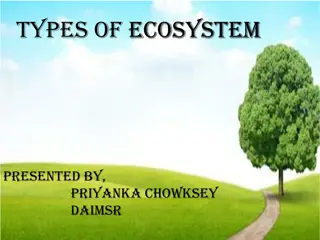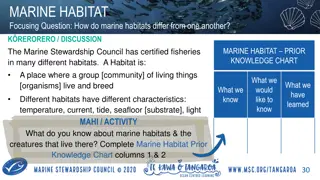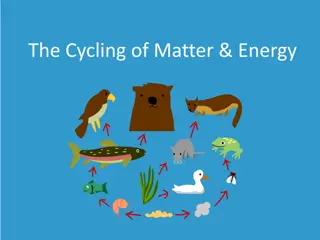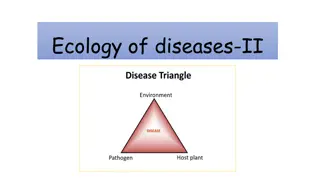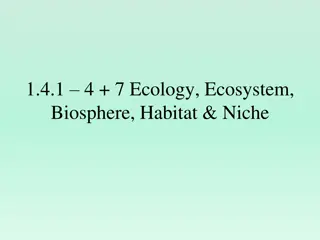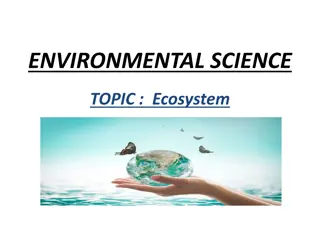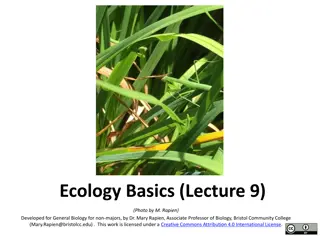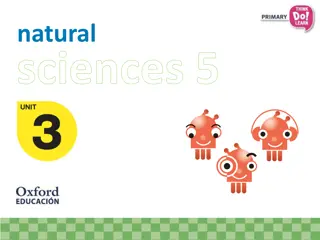Exploring Different Types of Ecosystems and Their Characteristics
Ecosystems are diverse environments encompassing both living organisms and non-living factors. From forest and grassland ecosystems to deserts and tundras, each type has unique features and interactions. Forests house a variety of organisms, while grasslands are dominated by grass and herbs. Deserts, with minimal rainfall, showcase remarkable adaptation strategies by plants and animals. Tundras endure harsh cold winters and short summers. Understanding these ecosystems is crucial for environmental conservation.
Download Presentation

Please find below an Image/Link to download the presentation.
The content on the website is provided AS IS for your information and personal use only. It may not be sold, licensed, or shared on other websites without obtaining consent from the author. Download presentation by click this link. If you encounter any issues during the download, it is possible that the publisher has removed the file from their server.
E N D
Presentation Transcript
ECOSYSTEMS TYPES
An ecosystem or biome describes a single environment and every living (biotic) organism and non-living (abiotic) factor that is contained within it or characterizes it. An ecosystem embodies every aspect of a single habitat, including all interactions between its different elements.
1.Forest Ecosystems includes plants, animals and microorganisms that live in coordination with the abiotic factors of the environment 2.Grassland Ecosystems the vegetation is dominated by grasses and herbs such as temperate, savanna, etc. 3.Tundra Ecosystems devoid of trees and are found in cold climates or where rainfall is scarce. The ecosystem in the Arctic or mountain tops is tundra type 4.Desert Ecosystem found throughout the world. These are regions with very little rainfall 5.Freshwater Ecosystem includes lakes, ponds, rivers, streams and wetlands. 6.Marine Ecosystem includes seas and oceans.
A forest ecosystem is a community of organisms that lives within a forest. A forest is usually defined as a large group of trees. However, other important aspects of a forest are the shrubs, the leaf mulch on the floor and the plants that live in tandem with the trees.
Grassland Ecosystem Tropical grassland ecosystem. Savanna is an excellent example of the tropical grassland ecosystem. Temperate grassland ecosystem. North American Prairies is an excellent example of a temperate grassland ecosystem. Flooded grassland ecosystem. As the name suggests, flooded grasslands have water throughout the year. Tundra grasslands ecosystem. Tundra grasslands are also known as polar grassland.
Desert ecosystem is the driest ecosystem of the earth and this is the reason it has less vegetation and less diversity of life. It is one of the parts of the terrestrial ecosystem. The plants and animals of the desert ecosystem have mastered the art of survival in harsh conditions. A desert ecosystem is basically devoid of any rainfall or precipitation. In short desert ecosystem is the community of living and non-living organisms living together and interacting in an environment which seems to be abandoned. A Desert ecosystem is the interaction between both the Biotic and Abiotic components of the environment.
Tundra Ecosystems This ecosystem usually has a long cold winter and a very short hot summer. The tundra ecosystem is extremely windy with high snowfall and less rainfall. The temperature in these regions goes below freezing point at night times. ...
Freshwater Ecosystem Most of the Earth Surface (around 70%) is covered with water, but not all the water is freshwater. Only 3.5% is freshwater, and the rest 96.5% is saltwater in the form of oceans. The Freshwater is found in the form of ponds, lakes, streams, frozen water, etc. other than oceans and seas. The freshwater ecosystem plays an important role in biodiversity. However, it is less extensive as compared to the saltwater ecosystem.
Marine ecosystems are vast and most stable ecosystems on the earth and are of great ecological importance. The seawater is salty with an average of 3.5%. Sodium chloride (NaCl), potassium, magnesium, and other necessary minerals present in seawater. The marine ecosystem is important because gives marine life such as fish, reptiles, invertebrates, sharks, and other aquatic animals.



